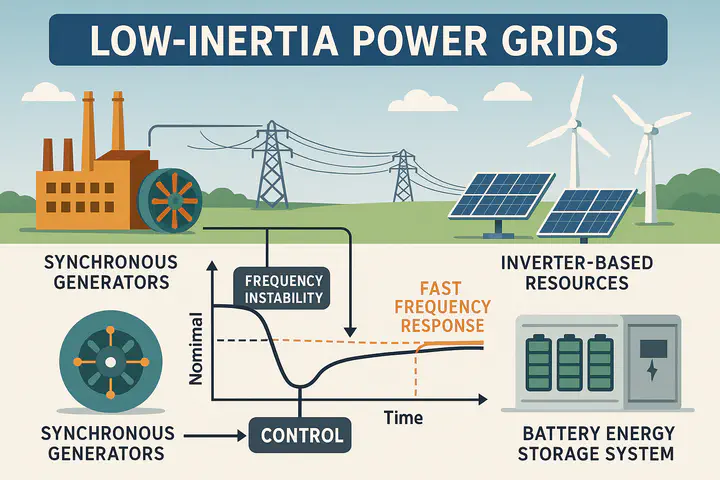Low-inertia Grids

The transition to power systems dominated by renewable energy sources (RES) such as wind and solar presents unprecedented challenges for grid stability, reliability, and resilience. Traditionally, grid frequency stability has relied on the physical inertia provided by large synchronous generators—hydro, steam, or gas turbines—which store kinetic energy in their rotating masses. This inertia acts as a buffer, slowing frequency changes in the event of sudden generation or load imbalances and giving time for frequency control mechanisms to respond.
With the increasing displacement of synchronous generators by inverter-based resources (IBRs)—including photovoltaics and modern wind turbines—the grid’s inherent inertia is drastically reduced. Inverter-connected RES do not naturally contribute rotational inertia; even wind turbines, when connected through power electronics, are decoupled from the grid’s frequency dynamics. As a result, low-inertia grids experience faster and more severe frequency deviations after disturbances, increasing the risk of instability and the activation of emergency schemes like under-frequency load shedding (UFLS).
Key Research Themes and Challenges
Frequency Stability and Security
In low-inertia systems, frequency can drop rapidly following a generation loss, risking equipment disconnection, load shedding, and even blackouts. Traditional frequency containment reserves (FCR) and kinetic energy (KE) are less effective, necessitating new approaches to maintain frequency within safe bounds.Curtailment and Reliability Trade-offs
To ensure frequency security, system operators may be forced to curtail renewable generation or activate UFLS, both of which are undesirable. Curtailment limits RES integration and increases operational costs, while UFLS reduces supply reliability.Advanced Frequency Support Mechanisms
Fast Frequency Response (FFR) technologies—often delivered by battery energy storage systems (BESS) or advanced inverter controls—are emerging as critical solutions. FFR can inject power within seconds of a disturbance, mitigating the frequency Nadir (minimum point) and reducing the need for load shedding or renewable curtailment.Control and Planning Innovations
The Sustainable Power Systems Lab, in collaboration with international partners, is at the forefront of research into advanced control, operation, and planning methods for low-inertia grids. This includes:- Comparative analysis and implementation of FFR controllers to optimize frequency support and minimize security risks.
- Development of data-driven, gradient-descent-based algorithms for optimal FFR sizing, enabling operators to meet frequency Nadir targets with minimal computational effort and investment.
- Integration of dynamic security assessment (DSA) and scenario-based planning to ensure robust operation across a wide range of real-world conditions.
- Investigation of new inverter control paradigms, such as virtual synchronous machines and virtual induction machines, to emulate inertia and enhance stability.
Real-World Impact and Future Directions
Research at the SPS-Lab has demonstrated the effectiveness of these methods using the Cyprus power system as a living laboratory—a representative case for islanded, low-inertia grids with high RES penetration. Key findings include:
- FFR can significantly reduce frequency Nadir violations and UFLS activations, supporting higher levels of RES integration without compromising security.
- Optimal sizing and deployment of BESS for FFR can be achieved using advanced data-driven and dynamic modeling approaches, balancing cost and reliability.
- Allowing limited UFLS can further reduce the required FFR capacity, providing flexibility in investment and operational strategies.
Looking ahead, ongoing research is focused on:
- Hybrid storage architectures (combining batteries, flywheels, and synchronous condensers).
- Joint optimization of FFR placement and synthetic inertia provision.
- Stochastic and techno-economic modeling to address renewable variability and cost-effectiveness at scale.
“In this research theme, you will find work undertaken by our lab in collaboration with many other institutes to understand the impact and develop control, operation, and planning methods for the secure, economic, and resilient operation of low-inertia grids.”
The SPS-Lab’s research provides critical insights and practical tools for system operators and policymakers navigating the transition to sustainable, low-inertia power grids—ensuring that the future grid can be both green and secure.
